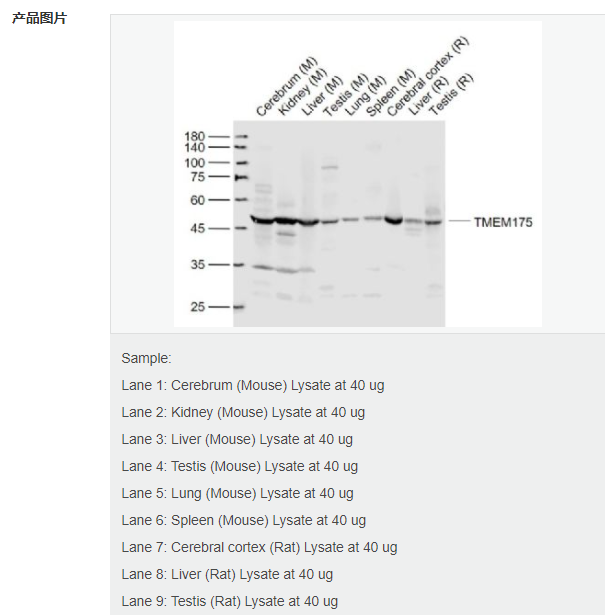
货号
产品规格
售价
备注
BN40540R-100ul
100ul
¥2360.00
交叉反应:Mouse,Rat(predicted:Human) 推荐应用:WB,IHC-P,IHC-F,ICC,IF,ELISA
BN40540R-200ul
200ul
¥3490.00
交叉反应:Mouse,Rat(predicted:Human) 推荐应用:WB,IHC-P,IHC-F,ICC,IF,ELISA
| 英文名称 | TMEM175 |
| 中文名称 | 跨膜蛋白175抗体 |
| 别 名 | MGC4618; Hypothetical protein DKFZp547K246; hypothetical protein LOC84286; Hypothetical protein MGC4618; TM175_HUMAN; tmem175; Transmembrane protein 175. |
| 研究领域 | 细胞生物 免疫学 跨膜蛋白 |
| 抗体来源 | Rabbit |
| 克隆类型 | Polyclonal |
| 交叉反应 | Mouse, Rat, (predicted: Human, ) |
| 产品应用 | WB=1:500-2000 ELISA=1:5000-10000 IHC-P=1:100-500 IHC-F=1:100-500 ICC=1:100-500 IF=1:100-500 (石蜡切片需做抗原修复) not yet tested in other applications. optimal dilutions/concentrations should be determined by the end user. |
| 分 子 量 | 56kDa |
| 细胞定位 | 细胞膜 |
| 性 状 | Liquid |
| 浓 度 | 1mg/ml |
| 免 疫 原 | KLH conjugated synthetic peptide derived from human TM175:231-330/504 |
| 亚 型 | IgG |
| 纯化方法 | affinity purified by Protein A |
| 储 存 液 | 0.01M TBS(pH7.4) with 1% BSA, 0.03% Proclin300 and 50% Glycerol. |
| 保存条件 | Shipped at 4℃. Store at -20 °C for one year. Avoid repeated freeze/thaw cycles. |
| PubMed | PubMed |
| 产品介绍 | TMEM175 (Transmembrane Protein 175) is a Protein Coding gene. Function: Organelle-specific potassium channel specifically responsible for potassium conductance in endosomes and lysosomes. Forms a potassium-permeable leak-like channel, which regulates lumenal pH stability and is required for autophagosome-lysosome fusion. Constitutes the major lysosomal potassium channel. Subunit: Homodimer. Subcellular Location: Membrane. Tissue Specificity: Widely expressed. Similarity: Belongs to the TMEM175 family. SWISS: Q9BSA9 Gene ID: 84286 Database links: Entrez Gene: 84286 Human Entrez Gene: 72392 Mouse SwissProt: Q9BSA9 Human SwissProt: Q9CXY1 Mouse Unigene: 478936 Human Unigene: 258324 Mouse Unigene: 159765 Rat Important Note: This product as supplied is intended for research use only, not for use in human, therapeutic or diagnostic applications. |
